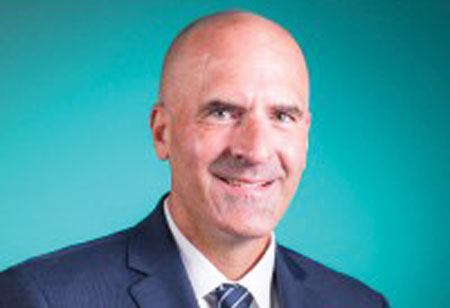Thank you for Subscribing to Healthcare Business Review Weekly Brief

How do we define the meaning of "Clean" from the patient's point of view
Healthcare Business Review
Todd S. Danos, MBA, LOTR, FACHE, is a dynamic healthcare executive with a proven track record in operational leadership, patient satisfaction and team engagement. With extensive experience in hospital administration, he currently serves as the Assistant Vice President of Hospital Operations at Manning Family Children’s, overseeing multiple departments and leading strategic growth initiatives. A LEAN and Just Culture expert, Todd has successfully driven efficiency, accreditation achievements, and financial improvements throughout his career. He is a published author, grant recipient and active member of professional organizations, consistently demonstrating leadership in healthcare innovation and performance excellence.
When discussing healthcare, cleanliness is one of the most significant factors influencing patient trust, satisfaction, and overall experience. While healthcare professionals and institutions may define cleanliness in terms of sterility, hygiene protocols, and regulatory compliance, patients have a more nuanced and experiential understanding of the term. For patients, “clean” is more than just an absence of germs; it encompasses physical cleanliness, environmental aesthetics, emotional comfort and a sense of safety. Understanding cleanliness from a patient’s point of view is crucial for improving healthcare experiences and outcomes.
For patients, ‘clean’ is more than just an absence of germs; it encompasses physical cleanliness, environmental aesthetics, emotional comfort and a sense of safety
The Physical Aspect Of Cleanliness
For patients, physical cleanliness is the most immediate and tangible aspect of a healthcare setting. This includes:
Personal Hygiene
Patients expect healthcare providers to maintain high standards of personal hygiene. Clean hands, neatly groomed appearances and fresh uniforms are fundamental expectations. A doctor or nurse who appears untidy may cause patients to question the overall hygiene standards of the facility. Patients also appreciate when staff use hand sanitizer or wash their hands in their presence, reinforcing a commitment to hygiene.
Facility Cleanliness
From waiting rooms to hospital beds, the overall cleanliness of a healthcare facility significantly impacts a patient’s perception. Patients expect to see:
• Clean floors free from spills, dust, or clutter
• Sanitized equipment and examination rooms
• Well-maintained and odor-free restrooms
• Proper disposal of medical waste
Any deviation from these expectations can lead to discomfort and a lack of confidence in the care provided.
The Psychological and Emotional Aspects of Cleanliness
Cleanliness is not just about what patients see; it is also about what they feel. A hospital or clinic that looks and smells clean provides patients with a sense of security and calm. On the other hand, a disorganized, cluttered, or dirty environment can increase anxiety and discomfort.
Aesthetics And Atmosphere
Aesthetic aspects of cleanliness, such as natural lighting, well-maintained furnishings and pleasant scents, contribute to a patient’s overall experience. Hospitals and clinics that incorporate elements of hospitality, such as fresh linens, uncluttered spaces and soft lighting, create an environment where patients feel more at ease.
Trust And Perceived Safety
Patients equate cleanliness with safety. A clean environment signals that the facility takes infection control seriously, leading to greater trust in medical professionals. On the contrary, any sign of neglect—such as overflowing trash bins or stained bed linens—can make patients feel unsafe and apprehensive about their care.
Cleanliness In Patient-Centered Care
Patient-centered care focuses on treating individuals with dignity and respect while addressing their unique needs. Cleanliness is a major component of this approach, encompassing both physical and psychological well-being.
Communication And Transparency
Patients appreciate transparency regarding cleanliness protocols. If a hospital takes measures to ensure sanitation— such as routine cleaning schedules, air purification systems, or touch-free sanitation stations—it is beneficial to communicate these efforts to patients. This reassures them that their health and safety are top priorities.
Empowering Patients In Hygiene
Patients also value the ability to maintain their own cleanliness. Providing easy access to hand sanitizers, clean linens, and hygienic restroom facilities contributes to their comfort. Assistance in personal hygiene, especially for those with mobility limitations, is a crucial aspect of holistic care.
Cleanliness In The Era Of Covid-19 And Beyond
The COVID-19 pandemic heightened awareness and expectations of cleanliness in healthcare. Patients now pay closer attention to:
• Sanitization of surfaces and equipment
• The use of personal protective equipment (PPE)
• Social distancing measures in waiting areas
• Visible efforts to maintain cleanliness
Healthcare facilities must continue to uphold these elevated standards to reassure patients and prevent the spread of infections.
Conclusion
From a patient’s perspective, cleanliness is a comprehensive concept that includes physical hygiene, aesthetic appeal, emotional well-being and trust in the healthcare system. By recognizing and prioritizing these aspects, healthcare facilities can enhance patient satisfaction, safety and overall experience. A truly “clean” environment is one that not only meets medical hygiene standards but also fosters a sense of comfort, dignity and trust for every patient.









